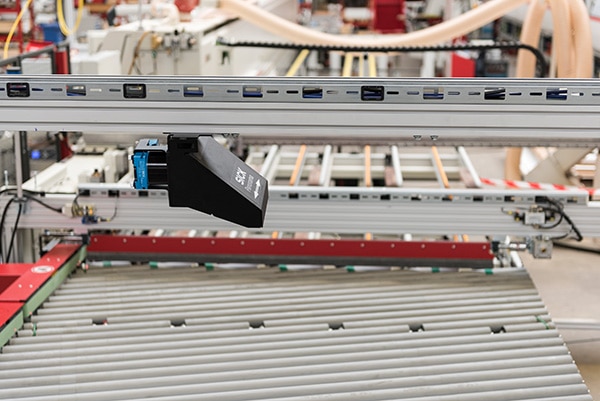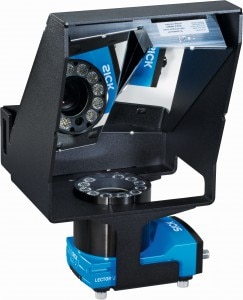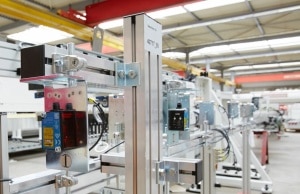In the last few years, the furniture manufacturing industry has started to move away from largely supply-oriented toward demand- oriented production. This presents two challenges to manufacturers of woodworking machines: the need for automated batch-size-1 production for large quantities, and therefore high variance in large quantities, as well as batch-size-1 production for high variance in medium to small quantities.

IMA Klessmann GmbH woodworking systems (Lübbecke, Germany) meets both requirements. Our core business is the concurrent growth of both individualization and automation in production, explains IMA Managing Director Bernhard Berger. We take the experience we gain with large industrial customers with respect to automation and then apply this to batch-size-1 projects for smaller and medium-sized customers.
The challenge: When will batch size 1 prove its worth?
In order to process edges of carcass parts and fronts, IMA commissioned SICK to design the sensor technology for a Performance.one system. The system operator, a manufacturer of high-quality designer furniture, cabinet systems, doors, and kitchens for a discerning private customer base, was looking for an automation solution to process small quantities with high variance. The system had to be in a position to reliably detect and process a highly diverse range of workpieces. Performance.one involves an IMA solution for commission-based and small batch production. The highly flexible circulation production system for formatting, gluing together and finishing edges with complete return is designed for flexible batch-size-1 production requiring virtually no manpower. To identify workpieces and then configure the machine settings, image-based code reading was recommended for this project. Image-based code readers are characterized by their flexibility in the selection of the code type. In addition to reading 1D bar codes, they employ a range of image processing algorithms to identify 2D codes, such as the frequently used Data Matrix, QR, or MaxiCodes, as well as plain text. They make light work of switching from bar codes to 2D codes.
System optimized with just one camera
For every identification task, the same question is asked: Which technology is best? And as it so often is in life, there is never just one answer for every question. The best possible solution is always tailored to the individual technical and economic conditions of the application. With Performance.one, the challenge was to reliably identify a small code over a large width. Normally, we would have had to set up two cameras to cover this width, explains Ulrich Sievers. Instead, the SICK team recommended using a Lector65x image-based code reader with Panorama mirror hood. The mirror hood helps to widen the field of view and is mounted together with the code reader either for top reading or side reading. In this combination, the code reader can be used for automated, fixed identification and decoding of bar codes on moving objects. It enables an approx. 50% larger field of view with the same code resolution.

Concerning the joint project with SICK, Ulrich Sievers remarks, Here, we were mostly concerned with scanning reliability. That is what is required again and again. The difficulty lay in reading a small code over a large width. By using this Panorama hood, we didnt need a second camera and simply expanded the field of view. We use the code to set the production parameters. Automatically. Because I (the workpiece) am passing by here, you (the machine part) have to do this and that with me. The component is recognized automatically. There are different board widths, different surfaces, and different contours. The code sets the machine. This is the essence of Industry 4.0, summarizes Ulrich Sievers.
A further challenge for the automation of the system was the presence monitoring concerning the workpieces. Photoelectric proximity sensors operating according to the triangulation principle were quickly pushed to their limits due to the different decors and shiny surfaces of the veneers. With the Dx35 distance sensor, SICK really had an ace up its sleeve, because the Dx35 reliably detects the presence of passing workpieces and can also measure their width.
Dx35 - flexible measurement or switch up to 35 m

The Dx35 product family of distance sensors, based on HDDM™ technology, combines reliability, measuring capabilities, and flexibility in one very compact housing. Depending on the application, subproduct families are available for distance measurement on natural objects (DT35 and DS35) or on reflective tape (DL35 and DR35). The sub-product families also come with different interfaces. In addition to the IO-Link function, which all the devices have, the product family also offers sensors with analog and switching output (DT and DL) or the option of two switching outputs (DS and DR). Finally, and not without a certain amount of pride, Ulrich Sievers describes the project as being more ambitious than large-scale production. He adds, Together with SICK, we have designed a Performance.one in batch size 1 for the customer.
Connected right into the living room
Aspects such as transparency and traceability are playing an ever more important role for manufacturers, because the level of variability in the production lines of furniture manufacturers is constantly increasing and assembly lines are seeing more and more variants being built in parallel. Vertical integration - that is the keyword for track and trace. Traceability of products during complex manufacturing and logistics processes is a priority for this integration. Production and logistics require transparent material flow so that production decisions can be made faster. Transparency of the material flow based on intelligent sensor technology also plays a critical role in delivery. Ideally, furniture manufacturing should now be controlled from behind - optimized for the delivery and construction of the furniture. Complex furniture systems such as kitchens can include over 100 order items. These should be loaded and unloaded according to the structural logic of the system. This works, for example, by reading out information that is already found in a QR code or a RFID tag of the veneer. This is how integrated information flows are established within a company or a companys system.
- Product information: Lector65x Image-based code reader, Dx35 mid range distance sensor
- Product overview: Image-based code readers, mid range distance sensors

